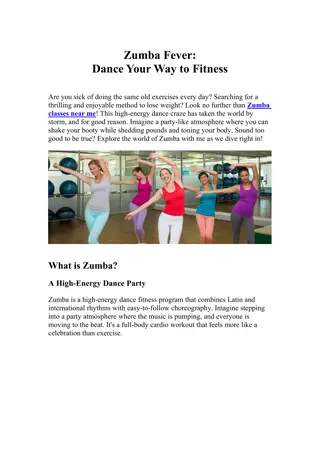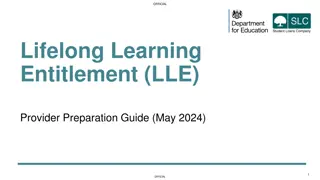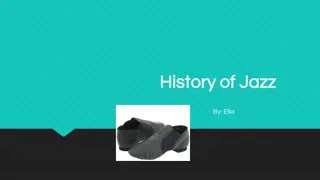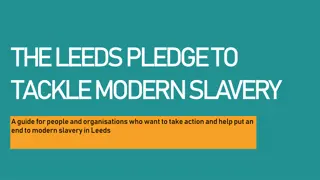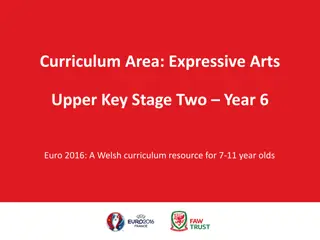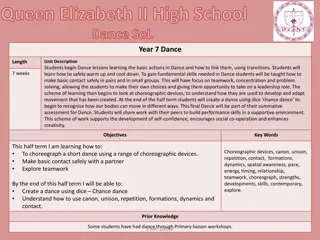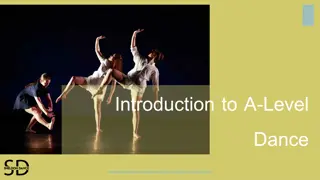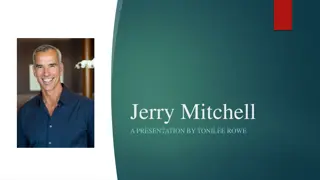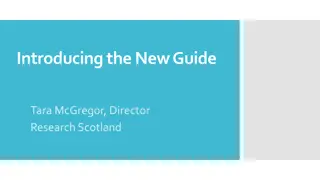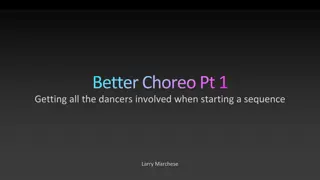
Choreography Essentials and Stimulus Definition in Dance
Gain insights into the essential elements of choreography in dance, including stimulus definition and understanding. Explore the significance of stimuli types and their application in choreographic pieces. Learn about the importance of aural settings and accompaniment in enhancing dance compositions.
Download Presentation

Please find below an Image/Link to download the presentation.
The content on the website is provided AS IS for your information and personal use only. It may not be sold, licensed, or shared on other websites without obtaining consent from the author. If you encounter any issues during the download, it is possible that the publisher has removed the file from their server.
You are allowed to download the files provided on this website for personal or commercial use, subject to the condition that they are used lawfully. All files are the property of their respective owners.
The content on the website is provided AS IS for your information and personal use only. It may not be sold, licensed, or shared on other websites without obtaining consent from the author.
E N D
Presentation Transcript
Whether you are creating your own work, performing dances created by others or looking at professional works, you need to have a good knowledge and understanding of the process of choreography AQA GCSE Dance You will be using the following tools: Stimulus Dance Planning Aural Setting Motif and Development Choreographic approaches Types of movement Outcomes Choreographic devices Dance relationships Group design Structure Actions, Dynamics, Spatial, Relationships 2
Stimulus Definition: ___________________________________________________________________ __________________________________________________________________________________ Name and simply describe the 5 types of stimuli with an example: 1._________________________________________________________________________________ 2._________________________________________________________________________________ 3._________________________________________________________________________________ 4._________________________________________________________________________________ 5._________________________________________________________________________________ For your current choreographic dance piece describe the stimulus you have chosen using the correct title and explain how/why it relates to this stimulus. (This must be clear and specific) __________________________________________________________________________________ __________________________________________________________________________________ __________________________________________________________________________________ __________________________________________________________________________________ __________________________________________________________________________________ __________________________________________________________________________________ Understanding of Stimulus: 1 2 3 4 5 Tip: Have a specific theme e.g. rather than water use a river journey 3
Why is this important? : ___________________________________________________________________ _____________________________________________________________________________________ Tip: It is often better to work out the dance idea first and then the music later The Dance Idea What kind of movements/motifs/ phrases will the dance contain? Title of Dance Solo/Group Structure of the dance Dynamic Content of Dance idea How will the dance be designed in the space? Beginning and Ending Movement words: 4
Cues Structure Story Rhythm/Tempo Interest Climax Accompaniment adds: Humour Style Phrasing Dynamics Sense of Place Drama Mood/Atmosphere Do you understand these reasons for using accompaniment? Write a small description next to each to show your understanding. For your current choreographic dance piece describe the aural setting you have chosen and explain how this demonstrates a good accompaniment for your idea __________________________________________________________________________________________ __________________________________________________________________________________________ __________________________________________________________________________________________ __________________________________________________________________________________________ Understanding of Aural Setting: 1 2 3 4 5 Tip: Listen to a range of music examples before choosing the best fit. 5
What is a Motif? __________________________________________________________________________________ ______________________________________________________________________________________________________________ Why are motifs important? __________________________________________________________________ _______________________________________________________________________________________ _______________________________________________________________________________________ Tip: once you understand how to use motifs you are on your way to being a good choreographer Using the following page, explain what motifs you have created in your choreographed dance piece and how you have adapted and changed them _______________________________________________________________________________________ _______________________________________________________________________________________ _______________________________________________________________________________________ _______________________________________________________________________________________ _______________________________________________________________________________________ Understanding of Motif and Development 1 2 3 4 5 6
How to develop a Motif (group) Travel Roll Feet Turn Arms Hands Balance Add Actions Use Different Body Parts Head Surfaces Fall Gesture Jump Legs Stillness Joints Add or take away Change order of Actions Motif Forwards and Backwards Shape Size Change or vary space Change or vary dynamics Energy Speed Level Flow Design Direction Weight Accent/ stress 7
What are the two aspects of the choreographic approach? 1._____________________________________________________________________________ 2._____________________________________________________________________________ How you approach your choreography depends on the following factors: The type of stimulus or starting point The theme or message you want to communicate The way you create your material with your dancers The type of movement you use The outcome you want to achieve How the choreography relates to other aspects of production e.g. accompaniment Communicating the theme of Journeys : Literal Symbolic Following pathways Creating obstacles for each other to get over/under/around Abstract Passing through the ticket barrier Travelling on the escalator Waiting for a train Pushing to get on Holding on to the handrail Two dancers pull, push, lift and manipulate each other across the space 8
Create a type of movement grid for your own choreographic idea Literal Symbolic Abstract How do you want your audience to feel when they watch your dance? ____________________________________ ________________________________________________________________________________________ Laugh, cry, feel calm, excited, entertained, intrigued, thoughtful How have you developed your dance to make them feel this way? _______________________________________ ________________________________________________________________________________________ ________________________________________________________________________________________ ________________________________________________________________________________________ ________________________________________________________________________________________ Facial expressions, accompaniment, lighting, actions, dynamics, relationships 9
Comic: features include character, facial expression, mime, situations Dramatic: features include mood, emotional content, conflict, issues Outcomes Abstract: explores a theme or idea in a non- representational way Pure: concerned with the movement itself Describe the type of dance you have chosen to choreograph in detail explaining how you will achieve your chosen outcome (using the above titles as a guide). _____________________________________________________________________________________ _____________________________________________________________________________________ _____________________________________________________________________________________ _____________________________________________________________________________________ _____________________________________________________________________________________ Understanding of Choreographic Approach 1 2 3 4 5 Understanding of Types of Movement/Outcome 1 2 3 4 5 10
Gives dances depth of interest Repetition repeat all or part of one or more motifs helps reinforce your choreographic idea and helps the audience to remember certain movements Write an example of where you have used repetition in your dance________________________________ _________________________________________________________________________________ __________________________________________________________________________________ Contrast (opposite) add something completely different to your motifs you have created e.g. you could change the dynamics of a movement from rigid to smooth Write an example of where you have used contrast in your dance_________________________________ _________________________________________________________________________________ _________________________________________________________________________________ Transition links between movements, phrases and sections of a piece of choreography. Should flow with the rest of the dance in a natural way. Write an example of where you have used transition in your dance_________________________________ __________________________________________________________________________________ __________________________________________________________________________________ 11
Gives dances depth of interest Highlights where you draw the audiences attention to specific movements, held positions or even phrases within the choreography. Usually the moments that the audience remembers the most. There can be more than one. Write an example of where you have used highlights in your dance________________________________ _________________________________________________________________________________ __________________________________________________________________________________ Beginning and End a catchy beginning immediately draws in the audience and an effective ending closes the show with a great experience. It is important to start and finish effectively and in line with the aural setting. Explain the beginning and ending to your dance______________________________________________ _________________________________________________________________________________ _________________________________________________________________________________ Climax this is the highpoint of the dance, you should choreograph your dance to lead to this point. It could include an element of surprise for the audience. This is essential to keep the audience interested. Write an example of where you have developed a climax in your dance______________________________ __________________________________________________________________________________ __________________________________________________________________________________ Tip: The end of the dance is probably the most important part, so have a clear idea of the last image you want the audience to see Understanding of Choreographic Devices 1 2 3 4 5 12
The connections and associations between a number of dancers Unison performing all at once e.g. to symbolise power and strength Write 3 examples of unison in your dance and why you have chosen to use this 1.________________________________________________________________________________________ 2.________________________________________________________________________________________ 3.________________________________________________________________________________________ Canon one or more dancers move after each other e.g. to symbolise a wave of movement adds interest through change Write 3 examples of canon in your dance and why you have chosen to use this 1.________________________________________________________________________________________ 2.________________________________________________________________________________________ 3.________________________________________________________________________________________ Mirror Image similar to unison however one or more dancers use the other side of their body or move in an opposite direction Write 3 examples of mirror image in your dance and why you have chosen to use this 1.________________________________________________________________________________________ 2.________________________________________________________________________________________ 3.________________________________________________________________________________________ 13
The connections and associations between a number of dancers Complementary dancers perform movements that are similar but not exactly the same as each other. It is rather like an echo e.g. one dancer walks, another runs, another leaps for a better/more interesting effect. Write 3 examples of complementary movement in your dance and why you have chosen to use this 1.________________________________________________________________________________________ 2.________________________________________________________________________________________ 3.________________________________________________________________________________________ Contrast where dancers perform movements that have different dynamics or different shapes can also be used with actions contrasted with stillness. Write 3 examples of contrast in your dance and why you have chosen to use this 1.________________________________________________________________________________________ 2.________________________________________________________________________________________ 3.________________________________________________________________________________________ Accumulation follow the leader. One dancer starts the dance and others join at various points to finish at the same time. Write 3 examples of Accumulation in your dance and why you have chosen to use this 1.________________________________________________________________________________________ 2.________________________________________________________________________________________ 3.________________________________________________________________________________________ 14
The connections and associations between a number of dancers Contact lift, touch, lean or support each other in a duo/trio/group. Good for exploring and expressing emotional content and relationships between dancers. Write 3 examples of contact in your dance and why you have chosen to use this 1._________________________________________________________________________________________ 2._________________________________________________________________________________________ 3._________________________________________________________________________________________ Question and Answer A group of dancers perform movements which are then contrasted or complemented by the rest of the group. Movement conversation. Can also be used in a duo. Write 3 examples of Question and Answer in your dance and why you have chosen to use this 1._________________________________________________________________________________________ 2._________________________________________________________________________________________ 3._________________________________________________________________________________________ Foreground/Background similar to a lead singer with backing singers/dancers. A lead dancer will perform with the rest of the dancers performing in the background with simpler material or repeated actions. Write 3 examples of Foreground/background your dance and why you have chosen to use this 1._________________________________________________________________________________________ 2._________________________________________________________________________________________ 3._________________________________________________________________________________________ Tip: Use a range of dance relationships to provide interest for the audience and support your idea for your dance. Understanding of Dance Relationships 1 2 3 4 5 15
Shapes and patterns created when a group of dancers perform Odds (trio/5) create assymmetry more opportunities for relationships. Allows for dramatic effect and comic in a trio Evens (duos/quartets) create a more balances and formal effect Tip: Consider the idea for your choreography and then decide the design of the dance that will best reflect this idea. How you use the number of dancers in a group in time, space and through actions. Lines Circles Curves Diamonds V-shapes Squares An example of 5 Dancers: 1 + 1 + 1 + 1 + 1: enter the stage 4 + 1: four in unison with one dancer still 2 + 3: contact work in a duo and trio 1 + 2 + 2: sequence of canon started by one dancer 5: all five dance in unison Provides visual interest and can help tell the story. What formations have you used in your dance and why? _______________________ _______________________ _______________________ _______________________ _______________________ _______________________ _______________________ _______________________ _______________________ _______________________ _______________________ _______________________ Provides visual interest, enhances the mood and meaning. Helps structure the dance. What numerical variation have you used in your dance and why? _______________________________ _______________________________ _______________________________ _______________________________ _______________________________ _______________________________ _______________________________ 16
Advantages Disadvantages Solo Easier to rehearse (especially if you are the only dancer) More material and development needed Duo/Group Easier to step out of view as an outsider Difficult to get dancers together to rehearse Less material needed and easier to develop You need good directing and interpersonal skills More opportunities for spatial design Understanding of Group Design 1 2 3 4 5 17
The framework on which a dance can be built Binary Ternary Rondo F u g u e Theme and Variation Tip: knowledge of structure will enhance your critical appreciation of dance 18
Binary 2 sections do not need to be of equal length. First section sets the scene and the second is a contrast. Both sections would need something in common such as key actions or a clear theme. E.g. Trapped/freedom Ternary 3 sections 1 and 3 are similar middle section provides a contrast. This is a cyclic form (circular feeling coming back to its beginning again) which helps provide balance and clear ending. E.g. At work tea break at work. Rondo This form has a chorus that remains the same but the melody of each verse is different to the one before. An example of this is The Pink Panther theme. You can explore the idea of a spy on the lookout: on the prowl-on the look out-falling into a trap-on the lookout. Fugue This is a complex and challenging form in which movement phrases from earlier in the dance are interwoven. Often used to build a climax at the end of the dance. An Example of this is the Brazilian Woolly Monkey dance in still life at the Penguin Caf reintroducing characters and their movement phrases from earlier scenes in a lively carnival to create a climax. Theme and Variation is a bit like Chinese whispers where the section develops from the one before so that the end cannot be predicted. The end will be very different from the beginning but the development will have essences of the section before in order to reach it. Narrative This is where the theme or storyline unfolds a section at a time. A dramatic theme can be developed through short sections or episodes made obvious through different pieces of music (song) to accompany each section. Tip: A dance with different sections needs to have effective transitions between each section. There should be a theme, idea or recognisable actions that hold the dance together 19
State which structure you will use for your choreography and explain the process through the structure. Use an image like on page 18 to support you. __________________________________________________________________________________________ __________________________________________________________________________________________ __________________________________________________________________________________________ __________________________________________________________________________________________ __________________________________________________________________________________________ __________________________________________________________________________________________ __________________________________________________________________________________________ __________________________________________________________________________________________ Understanding of Dance Structure 1 2 3 4 5 20
Refer Back to Page 8 for inspiration. Do you love your idea? If not think again. Find something to dance about Could you take an exam on your idea? Research the idea and make a plan for your dance Keep notes, draw diagrams, stick people and floor plans etc. Create some original action content appropriate for the idea; then develop it using space, dynamics and relationships Improvise and explore potential movement material. Explore a suitable range of actions and dynamics to communicate your idea Think about how you have used a variety of different relationships in a group dance can you use the different relationships to help communicate the idea? Create phrases and motifs and make choices does your chosen material relate to the theme/idea? MAKE SURE! Consider spatial design; pathways,, levels, directions, exits and entrances. Do you use a variety of relationships for a group dance? Select and discard Develop using Choreographic Devices Does the dance have shape where are the contrasts, highlights and climax? Think about transitions Structure Think about how you have used repetition with developments Think about your beginning and end ask for feedback all the time from teacher/peers. Does the beginning and end clearly relate to the theme/idea. Does it start and finish with the accompaniment? Refine Get lots of feedback. Show it to people, video it, evaluate it and amend it! 21
Re-write your plan until you have all the details you need. Create and adapt this plan on the next 2 pages to fit your needs and requirements. The Dance Idea What kind of movements/motifs/ phrases will the dance contain? Title of Dance Solo/Group Structure of the dance Dynamic Content of Dance idea How will the dance be designed in the space? Beginning and Ending Movement words: 22
To refine the progress of your work at any time! 1.How well have you used the stimulus? 2. Have you used original and varied action content? 3. Have you got contrasts in dynamics in your dance? 4. is there variety in the use of relationships? 5. Have you thought about your use of space, levels, pathways, entrances and exits? 6. Have you included several motifs which summarises the dance idea? 7. What about repetition and development, contrast and variation, and unison/canon? Have you thought about where they might feature in your dance? 8. Have you thought about creating a good start and finish (offstage/onstage)? 9. is there a climax to your dance, and are there highlights leading up to it? 10. Are there smooth and efficient transitions in the piece? 11. Is there a clear structure to your dance? 12. have you thought about choreographing the use of focus into the dance? 13. do you have moments of pause and stillness? 14. have you chosen an appropriate accompaniment to enhance your idea? 25
26 Tip: See if someone watching can understand what your dance is about
Understanding the ingredients of dance will help you to succeed in all aspects of the course. As a critic, you need to be able to describe and analyse movement, costumes, set design, lighting and accompaniment and possible meanings of dances As a dancer you need to learn, understand and use technical and expressive skills to help improve your performance. As a choreographer, you need to develop an understanding of the words used to create and develop movement for dances. 27
What are actions?_____________________________________________________________________ List the 5 types of actions with a definition and an example: 1.____________________________________________________________________________________ 2.____________________________________________________________________________________ 3.____________________________________________________________________________________ 4.____________________________________________________________________________________ 5.____________________________________________________________________________________ Basic actions on a dance theme It is important to choose appropriate actions if you want your dance idea or theme to be effective. If you are creating a dance based on trapped , you would probably choose a lot of gestures and stillness to help that dance idea come across. You would not look trapped if you were running and jumping all over the stage. 28
Hip Roll Nod Pause Adjust tie Freeze Stop Punch Gesture Stillness Suspend Balance Waving Hold Step Walk Travel Actions Run Tiptoe Leap Spring Jump Turn Pirouette Spin Bounce Tuck Twirl Whirl Pivot Straddle 29
What are dynamics____________________________________________________________________ List 5 reasons why Dynamics are important in Dance: 1.____________________________________________________________________________________ 2.____________________________________________________________________________________ 3.____________________________________________________________________________________ 4.____________________________________________________________________________________ 5.____________________________________________________________________________________ Choose actions and dynamics for the following: Freefall______________________________________________________________________________ Freeze/melt___________________________________________________________________________ Fly high in the sky_______________________________________________________________________ Walk on air____________________________________________________________________________ Seize the moment_______________________________________________________________________ Be overwhelmed with grief________________________________________________________________ Tip: it takes practice to be able to show very clear dynamics contrasts 30
Mechanical Floppy Strong Smooth Wavy Heavy Continuous Direct How the body moves Explosive Sustained Soft Sharp Slow Jagged Staccato Tip: it takes practice to be able to show very clear dynamics contrasts 31
What is space?________________________________________________________________________ List 5 ways space can be used in dance: 1.____________________________________________________________________________________ 2.____________________________________________________________________________________ 3.____________________________________________________________________________________ 4.____________________________________________________________________________________ 5.____________________________________________________________________________________ Tip: using space creatively, as with choosing actions, can help make a dance idea clear to the audience and give your dance visual impact. 32
Low Backwards Medium Sideways Down Levels Directions Forwards Diagonally High Up General Performing space On the spot Personal Around the room Large Around you Size Space (where the body moves) Small Proximity Near Far Rounded Wide Straight Body shape design Asymmetry Pathways (on the floor/in the air) Narrow Symmetrical Curved Twisted Angular Circular Angular 33
What are relationships?_______________________________________________________________ List 5 types of relationships: 1.____________________________________________________________________________________ 2.____________________________________________________________________________________ 3.____________________________________________________________________________________ 4.____________________________________________________________________________________ 5.____________________________________________________________________________________ Tip: using space creatively, as with choosing actions, can help make a dance idea clear to the audience and give your dance visual impact. 34
Turn Pull Unison Lift Canon Accumulation Push Contact Groups Formations Solo/chorus Fall and Catch Numerical variation Relationships (with whom we dance) Contrast Complement Meet and Part Partners Over/under/through/ around Act and React Counterpoint Lead and Follow Mirror Copy 35

![[PDF READ ONLINE] LAS VEGAS TRAVEL GUIDE 2023: DISCOVERING THE EXCITEMENT AND BE](/thumb/2060/pdf-read-online-las-vegas-travel-guide-2023-discovering-the-excitement-and-be.jpg)
![textbook$ What Your Heart Needs for the Hard Days 52 Encouraging Truths to Hold On To [R.A.R]](/thumb/9838/textbook-what-your-heart-needs-for-the-hard-days-52-encouraging-truths-to-hold-on-to-r-a-r.jpg)
